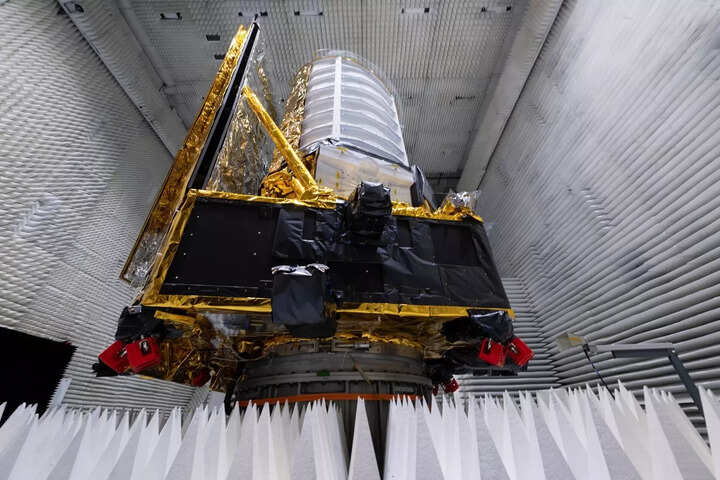ESA’s spacecraft to explore universe’s ‘dark mysteries’ launching this week
The European Space Agency (ESA) will launch the Euclid spacecraft to explore the dark mysteries of the universe on Saturday, US space agency NASA has said. Liftoff will be from Cape Canaveral Space Force Station in Florida, on a SpaceX Falcon 9 rocket.
“The ESA (European Space Agency) and SpaceX are targeting no earlier than 11:11 a.m. EDT Saturday, July 1, to launch the Euclid spacecraft,” NASA said in a statement.
The mission will shed light on the nature of dark matter and dark energy – two of the biggest modern mysteries about the universe. NASA is contributing to the Euclid mission by delivering critical hardware for one of the spacecraft’s instruments, providing science team funding, and establishing a US-based Euclid data processing center.
Euclid’s mission details
Astronomers haven’t been able to detect dark matter and dark energy directly to date. However, their presence has been deduced from their effects on the entire universe.
“Dark energy and dark matter reveal themselves by the fairly subtle changes they make to the appearance of objects in the visible universe; otherwise we don’t know about them,” said Rene Laureijs, Euclid project scientist, at a pre-launch briefing.
Euclid, the space telescope, will be responsible for observing the shapes and movements of billions of galaxies across 10 billion years of cosmic time to create the largest, most accurate 3D map of the universe ever produced. This mission is expected to cover more than a third of the entire outer space.
Read Also


This mission will help scientists track the position and velocity of galaxies over huge distances and through most of cosmic history. It will also help them to trace the way the universe has expanded during that time. The report mentions that Euclid’s enhanced optics will also reveal the minute distortions in the way galaxies appear.
Astronomers are planning to conclude the properties of dark energy and dark matter more precisely using the new data. The telescope that specialises in infrared (heat) and visual wavelengths will work together to image vast stretches of outer space. By charting its effects on visible objects, it will help astronomers to conclude where the dark matter may be lurking.
The Euclid team is expected to begin full operations around April 2024 and the $1.5 billion mission is planned to last until 2029.
FacebookTwitterLinkedin
end of article

The European Space Agency (ESA) will launch the Euclid spacecraft to explore the dark mysteries of the universe on Saturday, US space agency NASA has said. Liftoff will be from Cape Canaveral Space Force Station in Florida, on a SpaceX Falcon 9 rocket.
“The ESA (European Space Agency) and SpaceX are targeting no earlier than 11:11 a.m. EDT Saturday, July 1, to launch the Euclid spacecraft,” NASA said in a statement.
The mission will shed light on the nature of dark matter and dark energy – two of the biggest modern mysteries about the universe. NASA is contributing to the Euclid mission by delivering critical hardware for one of the spacecraft’s instruments, providing science team funding, and establishing a US-based Euclid data processing center.
Euclid’s mission details
Astronomers haven’t been able to detect dark matter and dark energy directly to date. However, their presence has been deduced from their effects on the entire universe.
“Dark energy and dark matter reveal themselves by the fairly subtle changes they make to the appearance of objects in the visible universe; otherwise we don’t know about them,” said Rene Laureijs, Euclid project scientist, at a pre-launch briefing.
Euclid, the space telescope, will be responsible for observing the shapes and movements of billions of galaxies across 10 billion years of cosmic time to create the largest, most accurate 3D map of the universe ever produced. This mission is expected to cover more than a third of the entire outer space.
Read Also


This mission will help scientists track the position and velocity of galaxies over huge distances and through most of cosmic history. It will also help them to trace the way the universe has expanded during that time. The report mentions that Euclid’s enhanced optics will also reveal the minute distortions in the way galaxies appear.
Astronomers are planning to conclude the properties of dark energy and dark matter more precisely using the new data. The telescope that specialises in infrared (heat) and visual wavelengths will work together to image vast stretches of outer space. By charting its effects on visible objects, it will help astronomers to conclude where the dark matter may be lurking.
The Euclid team is expected to begin full operations around April 2024 and the $1.5 billion mission is planned to last until 2029.
FacebookTwitterLinkedin
end of article
